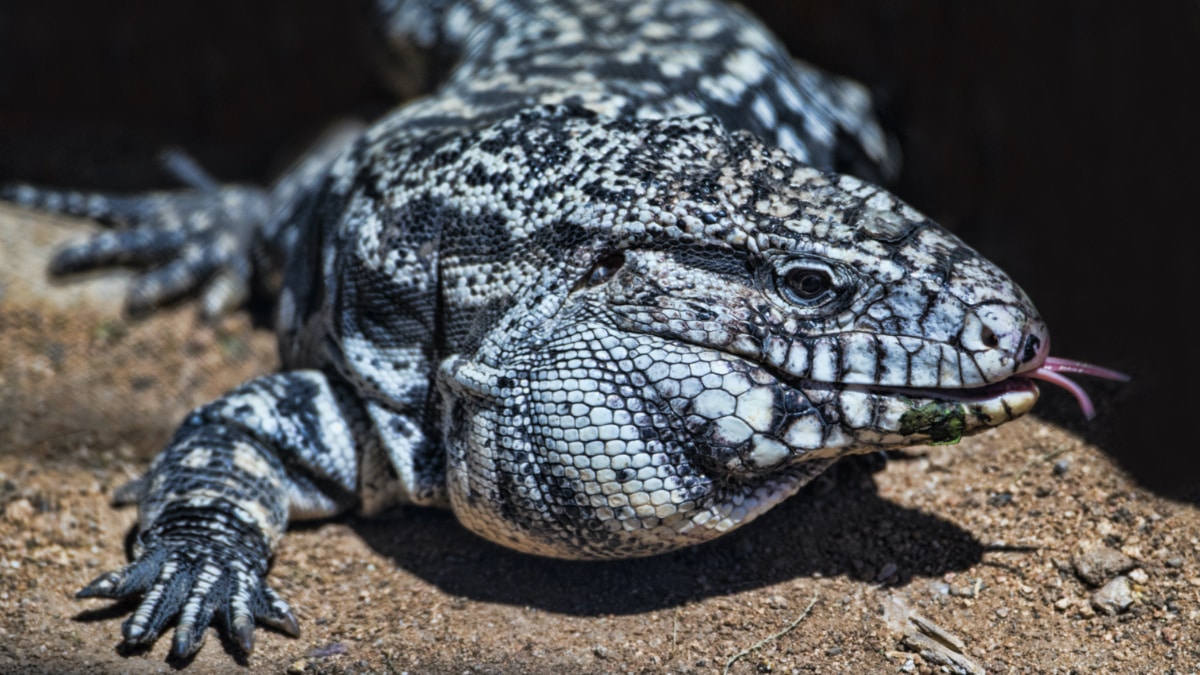

The Argentine black-and-white tegu is an invasive species that can reach four-feet long. Mark Newman / Getty Images
These black-and-white lizards could be the punchline of a joke, except the situation is no laughing matter.
That’s because the Argentine black-and-white tegu is an invasive species of dog-sized lizards that scientists worry could pose a threat to endangered species across the Southeast.
The tegus first came to the region as escaped or released pets and began to spread in South Florida more than a decade ago, National Geographic reported. But they are now reaching other states in the region and have been spotted in Georgia, South Carolina, Texas, Louisiana and Alabama.
“[T]he entire southeast portion of the United States is at risk,” U.S. Geological Survey (USGS) biologist Amy Yackel Adams told National Geographic. “Much of this area has a climate that is suitable for tegus.”
For scientists, the tegus’ eating habits are the most concerning aspect as they spread. The lizards, which are native to South America and up to four-feet long, consume everything from eggs and small birds to low-growing fruit. In Venezuela, they are nicknamed lobo pollero, or “the chicken wolf,” for their habit of stealing eggs from chicken coops. In the U.S., they could pose an additional hazard to the eggs of threatened or endangered species like the Eastern indigo snake.
Protecting native wildlife is a major concern in Georgia, where the tegus have been spotted mostly in Tattnall and Toombs counties, Discover reported.
“They are very efficient predators of our native fauna that don’t recognize them as predators,” Georgia Southern University biology professor Lance McBrayer told Discover.
Of special concern are ground-nesting birds such as quails and the gopher tortoise, which is the Georgia state reptile, Smithsonian Magazine reported.
However, the tegus’ egg-stealing ways also make them easier to trap, according to Discover. Seven were captured in Georgia in 2019 and six were captured this year. Those numbers are large enough that McBrayer thinks the lizards are likely breeding in the wild.
“We suspect that they are breeding, but we have not captured a juvenile,” he told Discover. “So, we can’t say with absolute certainty that there are baby tegus running around.”
McBrayer and Yackel Adams told Discover that the goal is to remove the lizards from Georgia before they can establish a population.
“We’re at that early invasion,” Yackel Adams told Discover. “It’s the best time to deal with it.”
Meanwhile, state officials are also working to stop the tegus from spreading in South Carolina, where they have been spotted at least nine times since August, WCIV reported in September.
“The number and distribution of black and white tegu reports in just a few weeks is concerning. Documented sightings come from as far north as Greenville County and as far south as Berkeley County,” State Herpetologist Andrew Grosse told WCIV.
“The individuals removed measured between two and three feet long and consisted of both females and males. Necropsies show the tegus have all been scavenging native plants and animals, including toads, various insects and muscadines. This indicates these individuals are wild, free roaming and foraging opportunistically. It is important that this species does not establish in our state.”
The climate is a key reason why tegus stand a good chance of spreading throughout the Southeast, since their native region is roughly the same latitude, McBrayer told Discover. Their range could grow even further as the climate crisis
expands tropical and subtropical conditions to the north, National Geographic reported.
- Giant Lizards Are Spreading in Georgia - EcoWatch
- Florida Bans 16 Invasive Species, Including Popular Pets
- Florida Bans 16 Invasive Species, Including Popular Pets

 233k
233k  41k
41k  Subscribe
Subscribe 